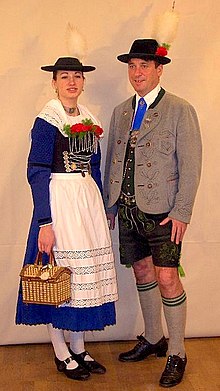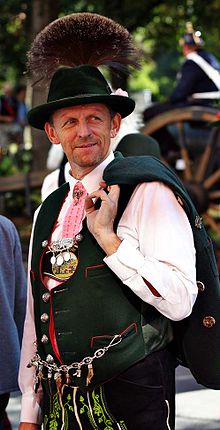Miesbacher costume
The Miesbacher costume is a very common costume in Bavaria . It is named after Miesbach , who is considered the cradle of the traditional costume movement.
The Miesbach costume is not a historical garb in the scientific sense. It only emerged around 1900 with the spread of traditional costume clubs from various historical currents in the Bavarian Oberland around Miesbach . The Miesbach costume has long become a global symbol for Bavaria, but also for Germany . Today the Miesbacher costume is at home all over Bavaria. It is most strongly represented in the Oberland and in Munich and the surrounding area.
Until 1950, the costumes within a club were broadly different, but with the economic growth a kind of uniformity set in. Before that, many parts of the costume had to be made by yourself, bar goods were not available. Many clubs have worked out other details of the Miesbach traditional costume over the years and specify these within their group.
Guideline
When furnishing the costume, the following should be noted: The jewelry and accessories grow with age and reputation, never the other way around.
Components of the boys and men costume
cap
The Miesbacher Scheibling is based on the hat shape of the melon . It is made from rabbit hair and gets the typical velor surface through long brushing. There is also a version made of wool. A two- or three-row cord is provided as a set. The hat is pushed in at the top, tilted slightly forward. A traditional man's hat must never get on someone else's head and never be taken off another's head. Taking off another hat means a declaration of dispute and usually ends in a fight. Furthermore, in most regions the greeting is either raised briefly (especially in the case of venerable people, e.g. clergy, or out of courtesy with women) or one briefly touches the brim. The hat is only removed for eating and when entering the church and church festivities.
Hat ornament
Various hunting trophies are common as hat decorations. Depending on the club membership, chamois beards , game cock feathers , Roagaspitz (wing feather of the Indian darter ). An eagle fluff is actually not used in the traditional costume worn in Miesbach, but it is widespread in Munich and the surrounding area. If the feather or the beard is attached to the hat with a slight inclination to the front, the wearer wants to signal his readiness to fight. Some forms of hat decoration have already fallen victim to species protection. Furthermore, badges and the like can also be found on the hats, whereby the jewelry, as already mentioned above, grows with age and reputation.
shirt
The original shirt with a bridge in white but also ivory-colored linen and mother-of-pearl buttons. The initials can be embroidered in broken letters on the bridge.
Tie
The royal blue silk tie is often found . The tie consists of a simple silk scarf with the dimensions approx. 40 × 40 cm, which is gradually folded towards the middle and then held on the collar with a tie pin or sleeve. Alternatively, crocheted ribbons or various shawls can be worn with the traditional Miesbach costume.
Members of a music band who perform in traditional Miesbach costumes very often do not wear ties at all, so that players of wind instruments do not have to breathe. However, this is again a group or club decision and is implemented uniformly by all musicians; that means, the drummers etc. also go without ties.
Lederhose with suspenders
The leather pants are available in very different craftsmanship. Hand or machine embroidered, split or deerskin, tailor-made or off the shelf. The trousers usually have moss green ornaments. The design of the ornaments is mostly based on very old templates. The trousers have a bib at the front, are tied with ribbons on the sides and have a knife pocket on which the initials can be embroidered. The seam decorations are simple cross stitch or the S-leaf pattern. Schuhplattler often have thinner pants to make the beat louder.
The strap of the suspender is between 2 and 3 cm wide, crossed at the back (often held by a silver clasp) and has the clasp over the table. More elaborate tables have old embroidery or horn decorations.
In the cold season, instead of the short lederhosen, black-gray-length-striped trousers are worn in the so-called half-costume, which are formally borrowed from the political official clothing around 1925 and are accordingly called Stresemann .
Gilet (vest)
Miesbacher vest made of green or purple velvet / felt , edged in red, back made of black silk, swallow pockets (curved) or box pockets and silver buttons. At the top, the vest is closed with one or two silver button chains.
Joppe
Miesbacher jacket in dark gray, light gray or gray brown. The jacket is not slit at the back and has no green felt applications. The inside of the jacket has a striped silk lining. The artist Raimund Jäger from Miesbach designed the embroidery patterns .
Socks
Dark gray wool socks that reach down to the knee with a dark green envelope and a tendril are worn from the heel over the calf. Some stockings also have a checked pattern in the envelope. To secure the stocking against slipping down, it is secured under the envelope either with an old shoelace or with a button elastic.
Band members often wear white woolen stockings; if so, then uniformly.
Shoes
The Miesbacher Buamaschua have an iron in their heels. The shoe is made of black leather, has a distinctive, high heel that curves convexly towards the middle of the shoe. In order to put a real tamper on the wooden floor while playing, the shoes are equipped with iron fittings in the shape of a horseshoe.
Jewellery
In addition to other jewelry, brooches or needles are often worn on the jacket (mostly awards from the prize plate or other honors). If these are not too big, they can also adorn the hat. Between the two outermost front buttons of the lederhosen there is sometimes a beer tip or a shariwari , a chain decorated with various old coins, claws, horn carvings or the like. A silver or silver-colored pocket watch with a spring cover belongs to the Miesbach costume. A wristwatch should not be worn with traditional costume.
knife
There are two different options for the knife: horn or goasfuas. The horn knives are usually shod with silver or decorated with horn carvings. The Goasfuas is in reality mostly a deer foot into which the blade has been worked.
badge
Club badges, badges of honor and other badges are worn on hats or jackets.
Components of the women's and girls' costume
garment
The traditional costumes of dirndls and women include the Leiblgwand or Spenzergwand with long sleeves, a skirt of the same color with a white blouse and apron, white silk stockings and black leather traditional shoes. The typical colors for skirt and bodice are blue or wine red.
The bodice with silk linen and string hat is primarily worn by married women, but also by younger women at high church festivals and special club celebrations. It consists of the so-called Schalk with a heavy bodice, the associated calf-length skirt and white apron. Black leather shoes and black silk stockings are also worn.
cap
The Miesbach traditional hat is usually worn with the Miesbach girls' costume, outside of Miesbach itself often with eagle fluff. The cord hat, a simple black pointed hat with gold-colored lacing, is worn by married women and generally at high church festivals.
Jewellery
The most important jewelry of the dirndl and younger women is the cord attached to the bodice with long needles, which consists of an approx. Four meter long chain with talers and a prick at the end. In addition to the obligatory hat jewelry, jewelry includes a multi-row necklace ("crop chain") as well as hair jewelry and earrings. Flower decorations are also worn on festive days. The accessory also includes a wicker basket and an umbrella.
literature
- Gerhard Maier: Miesbach - cradle of the traditional costume movement . In: The Miesbach costume. A piece of cultural history of the Miesbacher Oberland . (UT), 1976
- Miesbacherin. After the oil painting by M. Scholz. In: The Gazebo . Issue 30, 1884, pp. 501 ( full text [ Wikisource ] reproduction).
Web links
- Variety of costumes, u. a. colored rogue . Trachtenverein Alt-Miesbach Munich
- Traditional costume club Miesbach
- Umbrella organization of the Bavarian costume clubs


